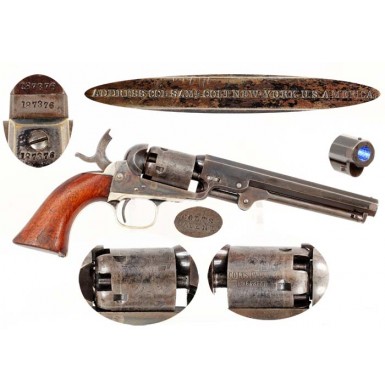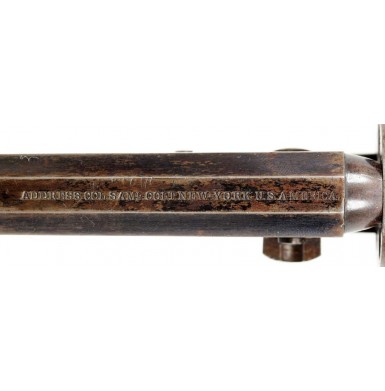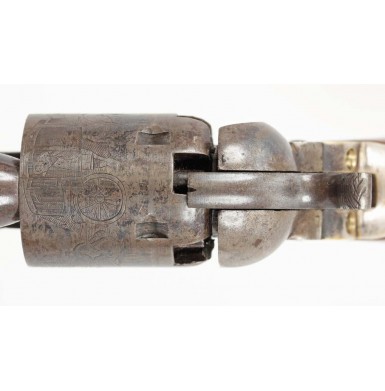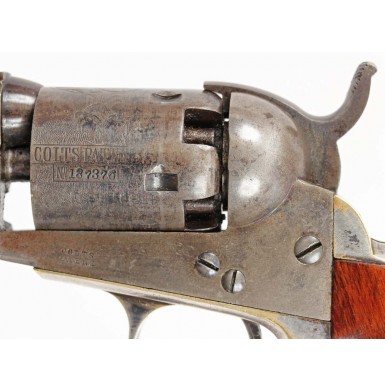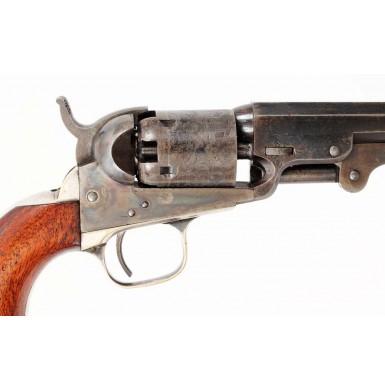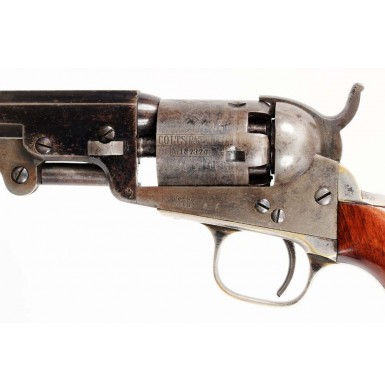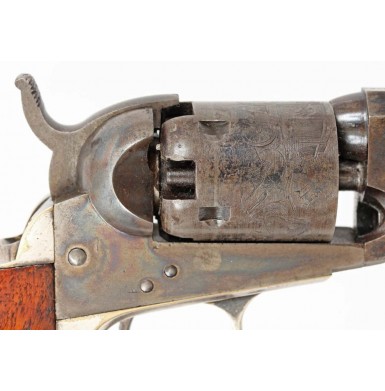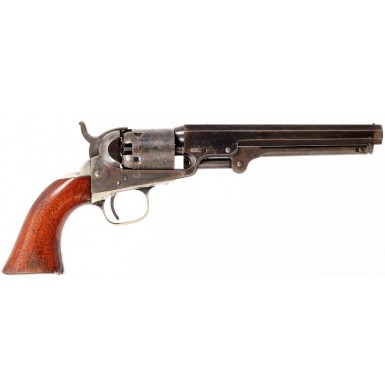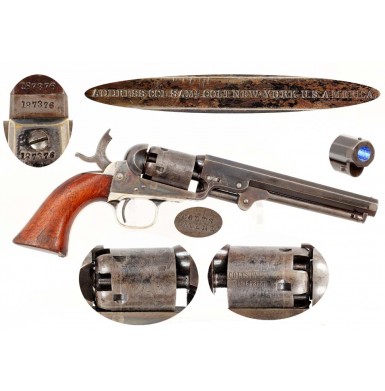This is a very fine condition example of the desirable 6” barreled Colt M-1849 Pocket Revolver. The M-1849 Colt Pocket was the most successful percussion handgun ever produced by Colt, with more than 325,000 being manufactured in the United States between 1850 and 1873, and another 11,000 or so being produced at Colt’s short-lived London manufactory. The 1849 Pocket was an improved version of the M-1848 Pocket Revolver, better known to collectors as the “Baby Dragoon”, which had first been manufactured in 1847 and remained in production through 1850, when the M-1849 Pocket Revolver superseded it. The “Baby Dragoon” had found a ready market among those who were taking part in the rapid westward expansion of the United States, and were prized possessions in the California gold fields of the 1849 Gold Rush. The relatively short barrel (typically 3” to 6”), the compact 5-shot cylinder and the small .31 caliber chambering all combined to make a relatively light weight (around 22 ounces or 1 pound 6 ounces with a 5” barrel) and compact revolver that could be carried covertly in a jacket or trouser pocket. The “Baby” did have some drawbacks, the most obvious being the lack of an attached loading lever on the majority of the production. The other issue was the square backed triggerguard, which could be caught on the edge of a pocket when the gun was pulled from hiding. The improved version, the M-1849 Pocket included a loading lever on all by the shortest barreled versions and a rounded trigger guard. Other changes from the early production “Baby Dragoons’ that were standard on the 1849 had appeared as improvements on later M-1848s and included an improved action with a roller on the bottom of the hammer, grease grooves on the cylinder arbor pin, and rectangular cylinder stop slots with a rounded concave profile along their leading edge. This improvement had been patented by Colt in 1850, was incorporated in all of their future percussion revolver designs and is still a feature found on nearly every revolver in production today. The 1849 Pocket also incorporated the roll engraved “Stagecoach Holdup” cylinder scene that had been introduced during the latter part of Baby Dragoon production. The Colt Pocket went into production in 1850, concurrently with the Baby Dragoon, and continued in the same serial number range. This means that early 1850 production (which started around 12,000) contained a mixture of “Baby” and “Pocket” revolver numbers overlapping within the same series, with the “Pocket” finally becoming the only handgun in that serial number range towards the end of 1850 (somewhere around serial numbers 14,000-15,000). The Colt M-1849 Pocket was produced in more variations than any other Colt revolver and it is generally estimated that a collection of about 200 M-1849s would be necessary to cover all of the primary variants. Due to the wide variety of features available, a “standard” M-1849 is hard to define, but in general a typical M-1849 was a 5 or 6 shot .31 caliber single action percussion revolver with an octagon barrel that was typically between 3” and 6” in length, usually with an attached loading lever. The backstrap, gripstrap and triggerguard were usually of silver plated brass, and the revolver was blued with a color case hardened frame and hammer. Standard grips were varnished one-piece walnut. The revolvers were, however, available with a dizzying array of finishes, barrel lengths, grip options, and engraving.
The Colt M-1849 Pocket Revolver offered here is a very desirable, high condition example with a 6” barrel and a serial number indicating that it was produced in 1861; at the outset of the American Civil War. It is probable that more Colt Pocket models went off to war with the average northern or southern solider in the spring of 1861 than any other handgun of the era. In fact by January of 1861 Colt had produced some 184,000 pocket models (including about 15,000 of his earlier Baby Dragoon revolvers), and Colt Pocket serial numbers had probably reached somewhere between 188,000 and 189,000 when Fort Sumter was fired upon on April 12, 1861. That production figure for a single series of pocket handguns exceeds many of the 19th century American firearms manufactures total output during their entire time in business! The revolver is in VERY FINE+ overall condition and rates very close to EXCELLENT. The serial number 187376 is clearly stamped on the bottom of the barrel, the frame, the triggerguard on the butt of the revolver, and even on the cylinder (which often has only the last 4 or 5 digits of the serial number). All of the serial numbers are matching throughout. The wedge is numbered with the last 5 digits of the serial number, 87378. The upper flat of the loading lever and the cylinder arbor both bear the last 4 digits of the serial number, 7376. The grip is numbered 7376 as well, in the backstrap groove, in a clear period hand, in period pencil. The revolver is 100% complete, correct and original in all respects and remains very crisp and sharp throughout. The barrel is marked with the last address variation of this series, reading ADDRESS COL SAML COLT NEW-YORK U.S. AMERICA in a single line. The cylinder has the usual COLTS PATENT panel box, over the box containing the serial number NO 187376. The revolver is crisply and clearly marked on the lower left side of the frame: COLT’s / PATENT, and there is no caliber mark on the rear left web of the triggerguard. The gun is in really in overall VERY FINE+ condition. It retains about 65%+ of its original bright blued finish on the barrel. The majority of the wear and loss is along the sharp edges of the octagon barrel and around the muzzle. The balance of the loss is simply from age. The blue shows some thinning from holster wear along the 5 upper most barrel flats, with the lower 3 flats retaining more of their finish with less obvious thinning. The barrel is free of any pitting, but there is some lightly oxidized freckling present on the face of the muzzle. The areas where the bluing on the barrel has thinned or worn have developed a pleasing gray-brown patina with plum undertones, which has blended with the remaining finish. Under strong light, some very minor oxidized age freckling can be seen mixed with the finish. The pistol shows the some of the usual impact marks on the right side of the barrel web where the wedge had been beaten out of the pistol during its service life, but not as severe as on many Colts that I have seen over the years. There are just enough marks to let you know that the gun did see some real use. The loading lever retains about 30% of its original vivid case coloring, most of which is at the rear half of the lever and on the protected side that rests against the barrel. The lever shows the most loss towards the end where it engages the lever catch and on the plunger itself. The balance of the lever is a smooth plum brown patina that matches the gun perfectly. The loading lever moves smoothly and operates correctly, locking tightly into place, as it should. The frame of the revolver retains about 70%+ coverage of the case coloring, but some of it is faded and muted, giving it about a 40%+ vivid case coloring rating. The faded coloring is a smoky brown base color with traces of blues, purples and yellows. The left side of the frame shows the most fading and retains only traces of vivid coloring in the recesses where the frame and recoil shield meet. The right side of the frame retains most of its vivid coloration and there the classic Colt purples, blues, browns and yellows are clearly visible and only slightly subdued from their original bright patterns. The frame is smooth, with crisp edges and very clear markings. The cylinder retains about 20%+ of its original bright blue, and appears to have flaked with age and light use. The balance of the cylinder has a smooth plum-brown patina that matches the left side of the frame well. The cylinder is extremely sharp and crisp and retains at least 95%+ of the roll engraved scene. The Stagecoach Holdup scene roll engraved on the cylinder rates EXCELLENT and is extremely clear, with practically no wear noted. All of the cones (nipples) in the cylinder are original and they are very crisp, but do show use, with pinpricking and light surface oxidation visible in their recesses. There is also some light pinpricking on the face of the cylinder from firing and use. The safety pins on the rear face of the cylinder are mostly battered and worn, with only one appearing to be in very nice shape. The brass grip frame, grip strap and trigger guard retain about 40%+ of their original silver-plating and are in very nice condition. The silver remains bright over much of the surfaces, with the plating loss most apparent on the butt, front of the triggerguard, and the lower portion of the backstrap. The action of the revolver is excellent, and the gun functions correctly, timing, indexing and locking up very tightly. The action of the pistol is extremely crisp. All of the screws are original and most are extremely crisp, with only a couple showing any noticeable slot-wear. All of the screws retain some of their fire-blued finish, with most showing fading and dulling from age. The bore of the revolver is in about FINE condition and is mostly bright with crisp rifling its entire length. There appears to be lightly scattered pitting along the entire length of the bore, with a couple of small patches of more moderate pitting towards the middle of the barrel. It is not clear how much of this is really corrosion and how much might be accumulated debris, and a good brushing might remove the majority of the ring. Otherwise, the bore is really in very nice condition. The original brass post front sight is in place on the top of the barrel, near the muzzle. The civilian style one-piece, varnished walnut grip is in about FINE condition. As noted it is numbered to the revolver and fits the frame of the gun perfectly. The grip retains 70%+ of its original varnish and is really attractive. The majority of the varnish loss on the bottom portion of the grip sides, where it has worn from carry and use. The left side of the grip shows the most loss in this area, suggesting the gun was carried in a holster for a significant amount of time, with the inside of the grip rubbing against the person carrying the revolver. The grip is solid and complete, and is free of any breaks, cracks or repairs. The grip remains fairly crisp but does show some scattered bumps and dings from handling and use, as would be expected. The right side of the grip shows a very tiny chip on the lower leading edge, and the left side shows this sharp lower leading edge worn from carry and use. Both areas of wood loss are extremely minor and in no way detract but are mentioned for exactness.
Over all this is a really wonderful example of a high condition Colt M-1849 Pocket Revolver with the scarce and desirable 6” barrel, manufactured in the days leading up to the American Civil War. While there is certainly no way to know if this revolver was carried off to battle by any soldier in 1861, the pistol would be absolutely appropriate for a display of early war soldiers items or to enhance a display of a company grade officer’s items. It would of course be a wonderful addition to any collection of Colt revolvers or Civil War era pistols, and I am quite sure that you will be very pleased with this very attractive, long-barreled Colt Pocket revolver.
SOLD
